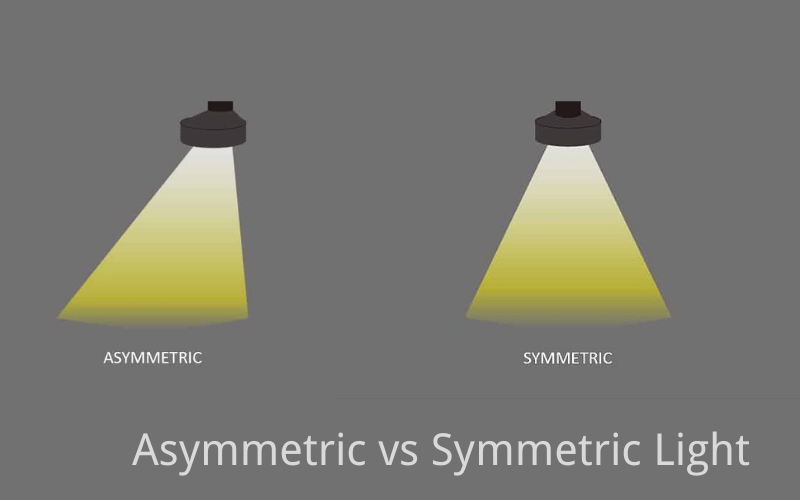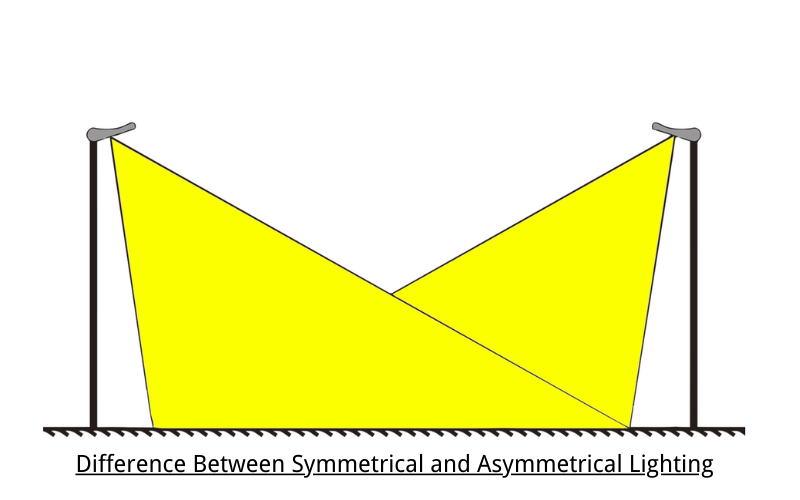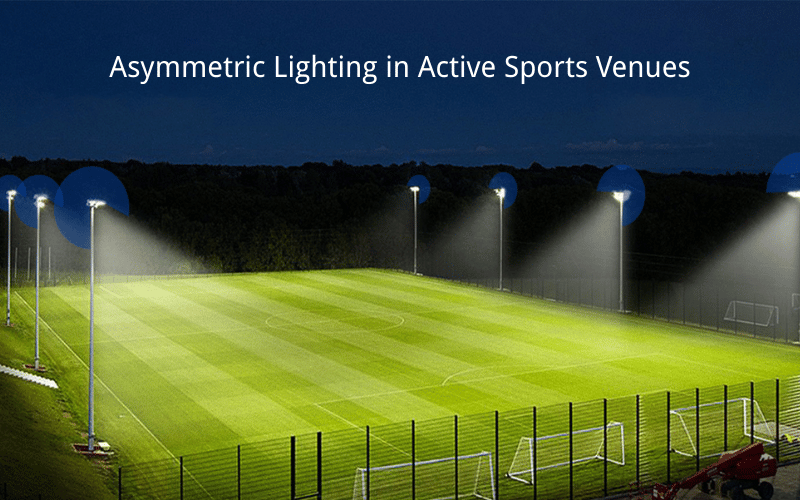Selecting the proper lighting type stands as a cornerstone of successful architectural design, dictated equally by functionality, efficiency, and aesthetic appeal. Among the array of lighting solutions, asymmetric and symmetric distributions present complementary yet distinguished roles that warrant close examination. Asymmetric lighting directs lumens to a defined, often narrow angle, thereby excelling in applications that demand precision—such as accenting architectural features, demarcating walkways, or illuminating task surfaces. Conversely, symmetric lighting disperses light equally in all radial directions, yielding uniform illumination that serves general-purpose requirements in environments like offices, vehicular circulation areas, and residential interiors. This article delineates the pertinent distinctions and application landscapes of each type, equipping the designer or engineer with the knowledge necessary for judicious selection in upcoming projects.
Table of Contents
ToggleUnderstanding Asymmetric and Symmetric Lighting
Definition of Asymmetric Light
Asymmetric lighting is engineered so that the intensity of light is deliberately uneven, directing strong output toward a particular target area while allowing surrounding zones to receive considerably less. This purposeful imbalance is particularly useful for directing light to vertical surfaces, pedestrian paths, or workstation surfaces, thus conserving energy and light output outside the zone of interest. Fixtures are commonly equipped with precisely engineered reflectors and optical lenses that constrain the light beam to a prescribed angle, effectively limiting glare and preventing spill. Consequently, asymmetric lighting is extensively applied for decorative accentuation, security-oriented outdoor flood lighting, and high-contrast task illumination.
Definition of Symmetric Light
In contrast, symmetric lighting distributes illumination evenly in a radial or hemispherical pattern from a central origin point. The intent is to provide uniform brightness in all horizontal and vertical planes, thereby achieving a calm and consistently lit milieu. Typical contexts for symmetric lighting include open-plan offices, expansive parking areas, and residential rooms, where the objective is to minimize fluctuations in light level, thereby limiting veiling reflections and shadows. Symmetric luminaires are constructed with uniform reflector geometries and diffuser components that fulfil the requirement for isotropy, ensuring that luminous intensity is the same from all horizontal and vertical horizons, guaranteeing a leisurely and evenly distributed illuminated environment.
Key Differences Between Asymmetrical and Symmetrical Lighting Selection
A discerning examination of asymmetrical versus symmetrical lighting aids the specification of the most effective strategy for any given scenario:
- Light Distribution: Asymmetrical luminance confines illumination to a defined plane, directing photometric energy toward a specified target. In contrast, symmetrical luminance radiates uniformly across a hemisphere, producing a predictable, uninterrupted luminance contour.
- Applications: Asynchronous illumination excels in selective tasks, namely accenting visual objects, delineating circulation paths, or sculpting the external surfaces of structures. Symmetrical illumination addresses broad-area, ambient-gen lighting, such as the even anchoring of ceilings, open-floor plates, or plazas.
- Fixture Design: Asymmetrical luminaires of construct feature engineered reflectors and/or precise lenses that collimate and refine the emitted light, expressly avoiding spill. Symmetrical luminaires deploy symmetric lamp layouts with parabolic or open reflectors engineered for uniform output, without the need for contouring applications.
- Energy Efficiency: Asymintrical lighting conserves electrical energy when the visual task demands a tightly defined light pool, thus curbing light extraneous to the target. Symmetrical lighting, supplying the same luminous task, may increase energy consumption to sustain uniformity when a discrete light beam could.
- Glare Control: AsContact illumination typically incorporates serrated baffles, diffuse glass, or low-origin apertures to moderate the visual discomfort of excess luminance. Symmetrical lighting, especially when mounted at high angles, may present defined sources leading to instruments and excessive discomfort.
By grasping these variances, practitioners may match illumination systems to the combined functional and aesthetic requisites of a given environment.
This table provides a clear and visually appealing comparison of asymmetric and symmetric lighting.
| Aspect | Asymmetric Lighting | Symmetric Lighting |
|---|---|---|
| Light Distribution | Directs light to a specific area, creating focused illumination. | Distributes light evenly in all directions for uniform coverage. |
| Applications | Ideal for pathways, accent lighting, task lighting, and building facades. | Best for general lighting in offices, parking lots, and residential spaces. |
| Fixture Design | Includes reflectors or lenses to direct light and minimize spill. | Uses uniform reflectors and diffusers for balanced light output. |
| Energy Efficiency | More energy-efficient for targeted lighting as it minimizes wasted light. | May consume more energy to achieve uniform illumination over large areas. |
| Glare Control | Reduces glare by directing light away from the viewer’s line of sight. | May produce more glare depending on fixture placement and design. |
Light Distribution Patterns
Asymmetric Light Distribution
Asymmetric light distribution directs luminous flux toward a predetermined area rather than equally around a luminaire, producing a purposeful divergence that confines illumination to a confined geometry. Precision-engineered reflectors, lenses, or optical systems govern the forward cut-off angles, with frontal intensity concentrated on the surface to be illuminated—commonly pathways, architectural walls, or technical workstations. This targeted geometry regulates spill light, thereby lowering electrical consumption per useful lumen emitted. Furthermore, when light intensity is confined to defined spatial planes, discomfort glare is attenuated; the configuration is hence advantageous in settings where users must maintain prolonged visual performance, such as contemporary office environments or gallery display cases.
Symmetric Light Distribution
Symmetric light distribution is predicated upon radial beam expansion, whereby emitted flux disperses uniformly in horizontal and vertical sections, producing equidistant photometric levels around the source. Wall-mounted, ceiling-suspended, or pole-mounted luminaires with symmetric photometric distributions fulfill the requirement for spatial equilibrium, as surface reflectance and vertical shadows are homogenized. This distributive symmetry is widely implemented in controlled-surface environments—ranging from surplus polyethylene globes in parking infrastructures to flat-panel ceiling-mounted systems within open-plan workspaces—thereby achieving the required supplementary vertical illumination for taf,security, comfort or ambience with reduced or null perimeter fall-off.
Both asymmetric and symmetric light distributions fulfill specific demands within an architectural context, enabling precision in fulfilling functional and aesthetic requirements across a spectrum of environments:
Asymmetric Applications:
- Pedestrian Routes and Roadways: The distribution casts light precisely onto pavements and carriageways, minimising sidelighting intrusion into adjacent properties and promoting visual comfort.
- Highlighting: Subtly focused beams accentuate three-dimensional forms, artwork, heritage ornamentation, or merchandise, framing interest regions without depleting the visual rest zones.
- Focused Work Settings: Individual or grouped task zones receive concentrated illuminance, affirming visual comfort and minimising glare for office stations, laboratory benches, or manufacturing task plates.
- Elevational and Sign Age Areas: Light patterned to precisely contour facades, carvings, or lettering, preserves sky glow control and skyline heritage while enhancing an evening identity.
Symmetric Applications:
- Interior General Lighting: Comprehensive, balanced illuminance guarantees visual comfort within open offices, lecture halls, or domestic living zones, suppressing distracting contrast.
- Extended Outdoor Venues: Reinforced distribution energises expansive areas—surface—mounted car parks, multi-field athletic venues, or municipal commons—while promoting orientation and safety.
- Wide-Pattern Flooding: Uniform, extensive distribution enables adaptable luminance for rigging, audience security, or construction activity, minimising the need for supplementary units.
- Ceiling and Integrated Fixtures: Harmonious light spacing eliminates pilfered shadows and dark bands in corridors, residential living areas, and public stairwells, fostering serene pathways.
A precise and informed understanding of the contrast and correspondences across asymmetric and symmetric distributions empowers designers to prescribe the most appropriate luminance architecture, ensuring concurrent fulfilment of cap, performance, durability, and atmospheric vision established within project briefs.
Choosing the Right Lighting Fixture
Considerations for Asymmetric Fixtures
When evaluating asymmetric lighting fixtures, emphasize their capacity to direct illumination precisely to designated locations. The following criteria merit close scrutiny:
- Beam Orientation: Confirm that the fixture supplies concentrated light to defined surfaces—walls, circulation paths, or work surfaces—while keeping spill light to an absolute minimum.
- Glare Mitigation: Seek fixtures incorporating integral reflectors or diffusers engineered to curtail glare, particularly in spaces such as open-plan offices or galleries, where occupant comfort is paramount.
- Energetic Efficiency: Prioritize models that optimize luminous efficacy without excessive power expenditure by confining light to the specified target.
- Application-Focused Design: Select fixtures engineered for distinct contexts, whether floodlights to light exterior areas or articulating task lights for concentrated work surfaces.
- Installation Angles: Check that the fixture permits mounting at the required tilt to achieve the intended light pattern without compromise.
Considerations for Symmetric Fixtures
Symmetric lighting fixtures excel in providing general illumination, yet their effectiveness hinges on the following attributes:
- Uniform Light Distribution: Confirm that the luminaire delivers consistent illuminance across the entire task plane, effectively minimizing shadows and ensuring that dark patches do not compromise visual performance.
- Coverage Area: Verify the luminaire’s lumen output and beam angle to ascertain whether the device can sufficiently illuminate the target environment, whether that is an interior room, an exterior parking area, or an athletic field of play.
- Durability: For installations exposed to outdoor or industrial conditions, select luminaires constructed of weather-resistant and mechanically robust materials capable of enduring prolonged exposure to harsh atmospheres.
- Energy Consumption: Specify energy-efficient luminaire types, such as LED-based symmetric distributions, to lower lifetime energy expenses while delivering the required illuminance level.
- Aesthetic Design: Assess the visual profile of the fixture, particularly within interior areas, to ensure compatibility with the architectural and decorative context of the space.
Comparative Evaluation: Asymmetric and Symmetric Fixtures
A comparative understanding of the photometric characteristics of asymmetric and symmetric luminaires is essential for an informed selection:
- Light Distribution: Asymmetric luminaires concentrate luminous flux in a defined direction, making them suitable for tasks that require selective illumination, such as aisle accentuation or pathway delineation. Symmetric luminaires emit light uniformly about the mounting plane, delivering broad, even illuminance and meeting the requirements of general lighting in expansive environments.
- Energy Efficiency: Asymmetric distributions enhance energy efficiency in applications characterized by concentrated tasks by confining luminous flux to the target surface and thereby minimizing spill light. Symmetric luminaires, by delivering light uniformly, may exhibit higher energy consumption in areas where illumination can be moderated by a more focused distribution.
- Glare Control and visual comfort are paramount in environments tailored to tasks or displays. Asymmetric luminaires are engineered to minimize discomfort by directing light precisely, while symmetric designs, when poorly positioned or overly bright, may generate unwanted glare in precisely the same context.
- Design Flexibility follows a parallel logic. Asymmetric fixtures can steer light toward a predetermined objective or corridor, creating dramatic or subtle transitions. Symmetric luminaires, by contrast, naturally diffuse light, succeeding in spaces that demand homogenous, all-round illumination without distinct transitions.
Contextual Applications further delimit the choice. Asymmetric luminaires excel when the objective is narrative or motion—illuminating a sculpture, marking the edge of a stair, or guiding a corridor. Symmetric designs govern environments such as open-plan offices, exterior parking zones, or indoor athletic fields, where uniform coverage is a core safety and operational requirement.
Considering glare, adaptability, and intended use, a judicious filter emerges, guiding the selection of the light fixture that satisfies both performance metrics and the visual character of the interior or exterior environment being designed.
Popular Uses in Lighting Projects
Asymmetric Lighting in Active Sports Venues
Strategic asymmetric lighting has become indispensable in venues where precise illumination governs athletic performance. Indoor or outdoor, these fixtures bias light within a controlled zone—such as a basketball court or a soccer pitch—delivering high vertical brightness precisely where it is needed, while extraneous spill toward benches, stands, or adjacent roadways is kept to a minimum. Focusing the optical assembly accordingly, the design not only curtails surface glare but also drastically lowers motion-flicker shadows, an advantage pronounced in high-speed events. This tighter distribution further lessens off-site light trespass, thereby curbing light pollution, a growing requirement among municipalities worldwide, especially in tournament-level contracts. The approach demonstrates commendable sustainability alongside operational efficacy.
Symmetric Lighting in Uniform Illumination
Symmetric lighting remains the workhorse for uniform illumination across a wide range of built environments. By mathematically choreographing symmetrical uplight and downlight, luminaries guarantee the same photometric outcome at all viewing angles, a requirement fulfilled in both task-oriented and amenity-driven spaces. In the workplace, such uniformity enhances the ancillary productivity of visual task acuity; in retail, it tempers merchandise shadows while amplifying architectural nuance. The symmetric pattern extends to outdoor surfaces, where road-grade, ceiling-mounted, or pole-mounted fixtures diffuse light evenly across parking lots, pedestrian thoroughfares, and expansive plazas. In both cases, the symmetrical fixture profile simplifies the aesthetic integration of multiple architectural layers, delivering trustworthy safety, pleasing ambiance, and the capability to optimize energy performance through controlled dimming strategies.
Floodlights: Asymmetrical versus Symmetrical Design Criteria
Floodlights may be specified in asymmetrical or symmetrical configurations, each architecture targeting fundamentally different illumination goals.
Asymmetrical floodlights utilize precision optics to concentrate illumination in a defined forward direction toward architectural surfaces, wayfinding signage, or competitive sporting boundaries. By shaping the light into a narrow, controllable pattern, these fixtures limit unnecessary divergence, realize lower energy consumption, and restrain uplight and horizontal glare. The resultant illumination achieves a defined boundary, promoting enhanced visual comfort in the emission zone and effectively preserving the surrounding atmosphere.
Contrastingly, symmetrical floodlights generate a nearly uniform, omni-directional light distribution, rendering them suitable for functional horizontal surfaces and expansive venues such as work zones, multi-tiered parking structures, and grandstand arenas. By emitting light radially from a central axis, they deliver consistent luminance levels, eradicate isolated dark patches, and fortify overall visual security from peripheral vantage points.
The selection matrix mandates a clear articulation of performance needs: for coincident architectural, promotional, or sporting tasks that demand felxible illumination, the asymmetrical solution prevails; for pervasive, uniform site illumination, the symmetrical architecture remains the mandatory deployment.

Understanding Photometrics
Photometric Analysis of Asymmetric Light Beams
The study of photometric processes governing asymmetric light beams centres on the controlled, non-uniform spatial distribution of luminous flux. By design, asymmetric beams project photometric data spatially, using advanced optics—parabolic reflectors, sectional lenses, or custom micro-lenses—to concentrate illumination on predetermined surfaces. The resulting distribution follows strict architectural or operational specifications, limiting unintended spill while increasing luminous efficacy. Comprehensive analysis quantifies parameters such as effective beam width, peak intensity, spatial distribution curves, and area uniformity ratios, assuring compliance with client and regulatory mandates. Using sports lighting as a case study, the photometric characterisation informs luminaire geometry and arrangement so that the field of play receives target illumination levels without exceeding the horizontal and vertical discomfort thresholds of players and spectators.
Photometric Evaluation of Symmetrically Emitting Light Beams
A symmetric light beam radiates luminous flux uniformly across all azimuthal angles, thereby constructing an illumination profile that is visually balanced and homogeneous. The photometric evaluation of such beams investigates their capacity to maintain a stable luminous intensity over an extended plane, exemplified by open parking decks, collaborative office spaces, and landscaped pedestrian settings. Principal photometric parameters include: total luminous output in lumens, angular beam spread measured in either degrees or effective illuminance diameter, and a quantifiable uniformity ratio across the target plane. Due to their self-canceling divergences, symmetric beams effectively mitigate the occurrence of undesirable shadow regions, allowing for consistently diffused illumination. Consequently, the evaluation quantifies compliance with defined safety and visibility criteria, thereby rendering the source applicable to both controlled indoor spaces and unconstrained outdoor environments.
Criteria Derived from UL Regulatory Guidelines
The process of fixture selection mandates an evaluation of Underwriters Laboratories (UL) criteria to secure safety, performance integrity, and regulatory compliance. The UL framework delineates requirements governing the design integrity, manufacturing tolerances, and validation protocols for lighting apparatus, assuring conformity to acknowledged market expectations. The selection process is thus governed by the following directives:
- Safety Authentication: Prefer units bearing conspicuous UL markings as evidence that comprehensive assessments of dielectric safety, thermal suppression, and mechanical durability have been satisfactorily completed.
- Environmental Classifications: Reference UL designations such as, but not limited to, “Damp Location” and “Wet Location” indicators to verify that the installed apparatus is compatible with the anticipated macro and micro environmental conditions, be it protected indoor service, unconstrained exterior exposure, or persistently humid microenvironments.
- Energy Efficiency: Specify luminaires that are UL-listed for energy efficiency to minimize operating expenses and advance corporate sustainability objectives.
- Application-Specific Standards: Where project requirements are unique—highly restrictive spaces such as hazardous areas or healthcare facilities—select luminaires that fulfill applicable UL requirements for those specific atmospheres.
Integrating photometric modeling with UL-recognized products provides a comprehensive strategy to verify that lighting solutions deliver the required photometric performance while meeting safety, performance, and regulatory benchmarks.
Frequently Asked Questions
Q: What is asymmetric lighting, and how does it differ from symmetrical lighting?
A: Asymmetric lighting is characterized by an uneven distribution of light, directing illumination toward designate zones without exhausting effort across surrounding surfaces. Conversely, symmetrical lighting disperses lumens evenly in all radial angles. Asymmetric lighting is especially suited to settings that require precision—view-oriented touches, repurposing walls and ceilings to add distinction, or boosting safe sightlines along pathways, stairwells, and entrances.
Q: How can asymmetric light sources reduce glare?
A: Asymmetric light sources mitigate glare by transporting photometry away from the observer’s horizon plane. The lamp’s optics angle the emergent beam forward or sidelong, thus restricting spill that might trespass into adjacent retina bother. The design is advantageous in high-rigorous zones, such as athletic facilities or temporary and permanent work sites, where the dank brilliance of travelling light can otherwise impair tasks and raise hazards.
Q: What are the advantages of using LED lighting in asymmetric fixtures?
A: The integration of LED sources within asymmetric configurations confers multiple efficiencies. LEDs, by virtue of their low wattage per lumen, long lumen-maintenance schedules, and remarkable directivity, drastically trim electrical expenditure and excessively long the attrition cycle versus legacy lamps. The resultant brilliance in focused, large-fields illumination attenuates discomfort glare, establishing the technology as the preferred choice for stadium emplacements, maxed-perimeter expos, and similar intensified-area regimes.
Q: In what ways does asymmetric light distribution improve general lighting in expansive interiors?
A: Asymmetric light distribution optimizes general lighting in large interiors by confining most of the luminous flux to functions zones—work planes, aisles, or architectural elements—while allowing peripheral light to attenuate naturally. This containment enhances visual comfort without increasing luminous output, cuts energy consumption, and decreases dependence on supplementary fixtures.
Q: How does the integration of an asymmetric lens alter the performance of a lighting installation?
A: By contouring the light emitted from the luminaire, an asymmetric lens confines the distribution to the designated surface, such as a vertical wall or building column. This geometric control not only minimizes unintended illumination of the ceiling or sky, but also confines synthetic skyglow—making the lens a critical device for photometric precision and energy stewardship in architectural and landscape applications.
Q: Is the deployment of asymmetric optics advantageous in the context of athletic illumination?
A: Indeed, asymmetric optics provide a decisive advantage in athletic lighting schemes. By directing the luminous flux toward the playing surface and strategically shaping the distribution, the fixtures achieve high task illumination while controlling glare zones for both competitors and spectators. This spatial control fosters visual clarity, guards collective safety, and potentially raises athletic performance by providing consistent visual references across the competitional plane.
Q: How does lumen output influence the performance of asymmetric lighting fixtures?
A: Lumen output directly influences the capability of asymmetric fixtures to deliver controlled illumination to designated surfaces. Increased lumen output promotes enhanced contrast and visibility across the intended area, allowing asymmetric units to function effectively in accent, area, or corridor lighting. Meeting the appropriate lumen threshold remains essential for compliance with established visibility and occupational safety regulations across varied applications.
Q: What distinguishes an asymmetric lighting beam from its symmetric counterpart?
A: An asymmetric beam shapes the distribution so that intensity gradients are confined to a prescribed direction, thereby restricting light spill and floor fixture spacing. By contrast, a symmetric beam disperses light uniformly about the vertical axis, resulting in no preferential direction. The controlled directionality of the asymmetric beam renders it superior for applications such as storage aisles and parking layouts, where concentrated illumination increases surface contrast and consequently safety for occupants and operators.
Q: In which settings is asymmetric lighting most frequently implemented?
A: Asymmetric lighting is routinely deployed in outdoor pathways, sports arenas, façade treatments, and temporary construction areas. The controlled spill, reduced glare potential, and enhanced lumen efficacy of asymmetric designs minimize light pollution while maintaining occupancy comfort and safety. Such features collectively lower energy consumption and therein extend the technology’s suitability to environments that require both performance and cost-effectiveness.
Concluding Summary:
A comprehensive grasp of the contrasts between asymmetric and symmetric lighting ultimately influences the efficacy of illumination schemes. Asymmetric solutions thrive in contexts that privilege focal accuracy—whether accentuating signage, grazing textures, or vertically washing surfaces—while symmetric sources furnish the uniformity imperative in broad coverage contexts. The decision matrix should therefore incorporate light distribution patterns, energy performance, glare mitigation, and the specific performance mandates of the design brief. Enlightenment of athletic courts, pedestrian corridors, or workstation cores is assuredly enhanced by the correct selection, reinforcing not only visibility but also occupant comfort and architectural coherence.
Related Posts
- LEDs & LED Driver: Operating Temperature in LED Lighting
- NEMA Socket for Street Lighting: Photocell Use?
- Lighting Power Density: Code Compliance for Green Building
- 300W LED Driver Guide: How to Choose the Right Power Supply for Your LED Light
- Golf Course Lighting: Exploring the Benefits and Design Steps for Perfect Illumination
- LED Driver: Difference Between Class 1, Class 2, Class II Power Supplies
- Solar Street Light Lighting Design & DIALux Calculation Guide
- LED Surge Protectors: Essential Surge Protection Devices (SPD) for Safe and Efficient LED Lighting





